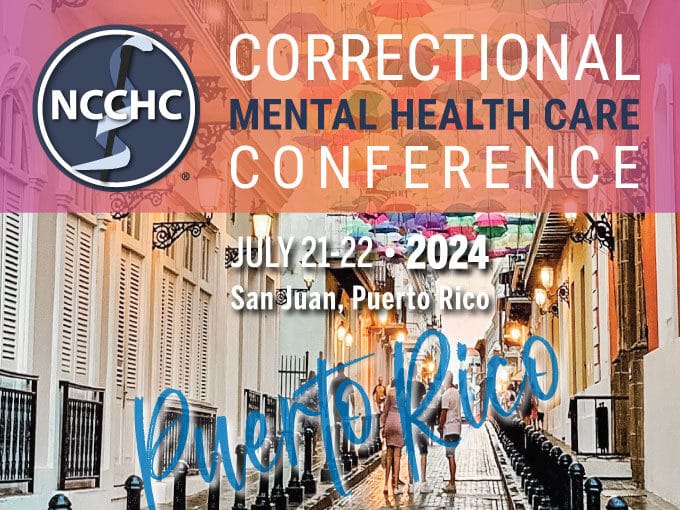
Say hola to Puerto Rico
The 2024 Correctional Mental Health Care Conference will be held in sunny San Juan!
Home Is Your Correctional System Overpaying for Off-Site Health Care?
 Oct 27, 2021
Oct 27, 2021Correctional health care leaders can have a major impact on controlling health care costs in ways you may have never considered. Performing services in-house, utilization review, and high-quality preventive medicine are well-established ways to manage expenses, but there’s more that can be done without compromising the quality of care provided.
My colleague Donna Strugar-Fritch and I will be presenting these ideas at the Virtual Fall Conference on Correctional Health Care. We will focus on three areas related to specialty care that must be procured from off-site providers and facilities: negotiating access and reimbursement, effective and efficient processing of claims for off-site services, and using data from off-site care to improve population health management and provider productivity. This blog gives an overview of all three.
Access and Reimbursement
Because the correctional system is historically divorced from the community health care system, the two have evolved along distinct pathways, with the correctional system often integrating only tangentially with the community health care market. Access to necessary specialty health services offered in the community is challenging to many jails and prisons. And even when robust access exists, the health services administrative infrastructure within a correctional environment may be unable to efficiently interface with community health services, especially when it comes to paying for services.
So let’s start there. Most correctional health leaders understand that they must pay for health services, and when it comes to necessary off-site specialty services, the providers must be paid directly. They may not, however, think of themselves as “payors” in the parlance of contemporary health care. Briefly, in the latter part of the 20th century, employers began to offer health benefits. The employers or the insurance companies they engaged were now payors. With the advent of Medicare and Medicaid, the federal and state governments became major payors. With expansion of these programs (e.g., through more covered services and more covered lives), government influence on medicine and health care has grown. Each group of payors, therefore, can negotiate and demand things from health care providers (professionals and facilities) and their influence depends on the share of the provider’s business they represent. There is a complex ecosystem of patients, payors, and providers within which money is exchanged for health services.
Where does correctional health care fit into this? Generally, it doesn’t. Correctional systems are usually in a simple fee-for-service relationship and are most likely paying non-negotiated rates that are far above the lowest rates negotiated by governments (Medicaid rates are generally the lowest). There are exceptions among state departments of corrections, but a minority of them negotiate favorable rates. This is an expensive irony, as most inmates are eligible for Medicaid (in expansion states). While it is true that federal funds cannot generally be used for providing medical services for nonhospitalized inmates (the infamous “inmate exclusion policy”), that could change in the future and, regardless, it makes sense to negotiate rates that patients would be eligible for when not incarcerated.
Negotiating favorable rates is no small task. Hospitals and professionals are not generally incentivized to accept lower payments for services. Why would they be? Health care is expensive to provide. Furthermore, to remain financially viable, health systems and providers must limit the number of low paying patients and make up for the difference with higher paying patient groups, usually those with commercial insurance. Nevertheless, and despite the complexity of the ecosystem, steps can be taken. Even small steps to understand and ultimately get control over health care costs can make a big impact on your budget.
What can you do? First, take a deep dive into the administrative aspects of how your facility pays for its outside health care services. If you work in a prison, this might be managed at central office and may include many different contracts for health services. If you are at a jail, most likely you have local relationships or a small network of relationships that provide services. Look at each contract and work with a budget analyst to understand how you are being billed. This is a highly technical area, so perhaps get help from knowledgeable partners to help you explore and sort through the arcane world of medical rate setting.
There are other options to get help, too. For jails, you might engage your county executive and budget officers to see if they can negotiate rates with local indigent care or public systems, or include the jail’s patients in rates they have negotiated with local health systems for public patients or employees.
Prisons systems can turn to the legislature to seek laws that require that care to prisoners be reimbursed at Medicaid or Medicare or public employee rates. Although there can be strong opposition from hospital associations and medical societies, the larger interest of the state general fund may prevail. Jails should be included in these arrangements. Large jails or groups of jails may be able to negotiate with providers to receive the same rates extended to the DOC. A sheriffs’ association and your state’s association of counties can be very effective advocates for this type of relief for strained county budgets.
Claims Processing and Data-Driven Improvement
This leads to the final two items: paying the claims for off-site services and the use of off-site service data to understand and manage population health and provider productivity. As you manage your off-site health expenditures, you will come face-to-face with the world of medical billing. Correctly adjudicating medical claims to be sure services were billed accurately and at the correct rates is a highly complex and specialized skill. Errors, double and triple billing, and unbundled billing in which you pay more than you should are all very common. They are generally avoided through the use of specialized claims adjudication software.
Health care claims payment is not the core business of any jail or prison; working with a professional adjudication system can reduce erroneous expenses and the hours your staff spends to track and process off-site claims. All jails and DOCs should consider either partnering with another public agency that is skilled in health care claims payment or contracting with a local, state, or national billing service.
Finally, data from off-site services can help control expenses. It also can give you important clinical insights into the health of your population and identify variance in provider productivity and clinical practice. This can improve primary care services at the prison or jail, which leads to a healthier population. For example, if you are sending patients to a hospital for diabetes emergencies, your chronic care clinic structure may not be effective in identifying and supporting your provider’s efforts, your formulary may need tweaking, your dietary services may need adjustment, etc. In larger systems, you may also see that certain sites are sending patients for emergency care more than others; data analysis can inform changes that reduce the variance and improve provider productivity and clinical outcomes.
Learn more
Watch our session at the Virtual Fall Conference or contact me for more information. NCCHC Resources can help you identify the next steps for saving significant money while supporting quality care.
By
Brent Gibson, MD, MPH, CCHP-P
Managing Director, NCCHC Resources
Request a meeting: https://calendly.com/brent_nri


